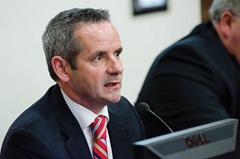Delivering better outcomes
 Paul Reid, Chief Operations Officer within the Department of Public Expenditure and Reform, heads up the implementation of the Public Service Reform Plan. He talks to Owen McQuade about progress in the first phase and how the next phase will build on the achievements so far and focus on outcomes for citizens.
Paul Reid, Chief Operations Officer within the Department of Public Expenditure and Reform, heads up the implementation of the Public Service Reform Plan. He talks to Owen McQuade about progress in the first phase and how the next phase will build on the achievements so far and focus on outcomes for citizens.
The first phase of public service reforms, as set out in the Public Service Reform Plan (November 2011), focused on “ways to consolidate and reduce costs and taking out duplication and waste by focusing on things like shared services, procurement, rationalisation, reducing staff numbers and improving expenditure controls,” according to Paul Reid.
“In the next phase of reform, we will continue that focus but with an equal focus on citizen engagement and improving outcomes. The next wave of reforms will also be about better outcomes for service users and for government.”
In recognising the progress made, Reid says it has firstly made a “significant contribution to improving our fiscal position”.
“It has made a major contribution in how Ireland is perceived in the markets and has helped immensely in increasing the confidence of the key stakeholders – the troika, the trade unions, business community, and the bond markets,” Reid remarks.
Increasingly, the Irish Public Service Reform Plan is getting recognition across European administrations. Reid and his colleagues in the Department of Public Expenditure and Reform (DPER) have spoken at the OECD in Paris, to the Spanish administration in Madrid and through the OECD have had invites to share their experience of the reform process with governments in Brazil, Cyprus and the UK. Reid comments there is a “strong” recognition of Ireland’s progress on reform of its public services and he thinks that “the particular piece the European administrations are picking up on are the outcomes from the Haddington Road agreement.”
Reid categorises the reform plan into three areas. The first area is around governance reform – “to increase transparency and build public trust,” says Reid – and he goes on to list the initiatives undertaken to achieve this: “Increased powers for the Ombudsman, extension of the [Freedom of Information] Act to a lot more public bodies and regulation around lobbying.”
In the second category are the “strategic” reforms which are “the major cross-cutting initiatives” such as shared services, procurement reform – which will save €500 million over a three-year period – property rationalisation through the government action plan on property, and expenditure control and a reduction in staff numbers by 30,000. “The payroll will have been reduced by 20 per cent by 2025.”
Reid acknowledges that these cross-cutting measures are the hardest from a change management perspective but “we are confident of the progress made in these strategic areas.”
The third category is operational and efficiency reforms. The biggest component of this category is the Haddington Road Agreement. Reid, who led the Government’s negotiation team in the agreement, says: “It gives absolute predictability in the Government pay bill between now and 2015 and it reduces it by €1 billion.”
The agreement also means that 15 million extra staff-hours will be worked in the system each year at no extra cost. It also has the commitment to a suite of longer term reforms in health, education, local government and justice. “It gives us a commitment to industrial [relations] peace and stability.”
Next phase
The ambition for the next phase is around four main themes. The first of these is to strengthen the focus on those reforms that “improve the outcomes for service users”. It will see the primary focus move from solely on cost-cutting to a parallel focus on better outcomes for citizens.
The second theme is to leverage the “reform dividend” which was referenced in Minister Howlin’s Budget 2014 speech. “We are making progress on reform and we want to re-invest some of the savings back into areas where there are requirements to improve front line services,” says Reid.
The third theme is “embracing digital” which focuses on opportunities for taking services digital and for sharing data. DPER has appointed a new Chief Information Officer and his role is to develop an ICT vision and strategy which will be launched in early 2014. “In this plan, we make the strategic intent to embrace digital and it is very much a ‘digital first’ approach to public services,” Reid adds.
“As part of this commitment, we have proposals to strengthen data sharing across departments and if we need to bring forward legislation to do this there is a commitment that we will do that. It is all about the experience of the citizen. If they register for a passport, driving licence or PAYE, this should be a seamless transaction.”
The fourth commitment is around “openness and accountability”. This will focus particularly on accountability within the public service.
The structure of the plan will have an emphasis not just on those cross-cutting measures but on the reforms that are happening in each of the sectors. This is really to reflect the priorities of each sector i.e. Civil Service, health, education, local government and justice: “The objective is to demonstrate movement across all sectors and to give an oversight across each of the sectors.”
Looking back on the first phase of reform Reid is asked, whether there were any surprises or perhaps did things go differently than expected? He replies: “When reviewing the first phase and then looking at the next phase, we needed to make a couple of judgments. Some elements of the plan are completed and we wanted to close them off. Others are still moving forward, such as shared services.
“With other elements the original commitments we had in the 2011 plan actually changed. An example of this is procurement. Our original actions in the plan were around incremental improvements, with more centralisation of framework contracts and more compliance.
He continues: “When we did our analysis during the early stages of the plan, it told us that we had to be more ambitious and to ‘leap frog’ forward. We then set out to establish a new procurement office and appoint a new Chief Procurement Officer and pull all procurement functions out of departments and into one central office.
“That has been a good learning exercise and it taught us to make sure we baseline every project we undertake. It is about examining where we are starting from and getting all relevant data. For example, in procurement, how much and where we are spending and in what categories. In shared services, we determine how many people are currently doing those transactions. We do a thorough baseline analysis before going into the business case.”
Another “big” learning point was around programme management. “We realised we were weak on programme and change management expertise across the public sector,” he adds. “One area we had to spend a significant amount of time on, both within DPER and the departments, was on building programme management offices [PMOs] with their governance structures.”
Reid explains: “We helped each sector put in place a PMO with a governance structure reporting to the Secretary General and a whole set of simple project and programme plans. We concentrated on the four main sectors: health, education, local government and justice. The second thing we did was facilitate the recruitment of change management expertise, with people appointed with expertise in shared services and managing programme offices.”
Citizen experience
The next phase of reform will continue with cost reduction but will shift the emphasis to improving outcomes and improving the experience for the citizen in interacting with the public service. Reid acknowledges that there are more risks in delivering projects and programmes that are externally focused than in delivering internal cost-cutting initiatives. An example of progress is the delivery of the property tax. Public acceptance of paying the tax aside, the delivery of the tax by the Revenue Commissioners has progressed well with the call centre function being outsourced, with 92 per cent compliance being achieved.
The next phase of reform will look at areas to strengthen the user experience and these are divided into two categories. The first is around new models of delivering services, including external service delivery. The second area is digital government which Reid says is a “key piece”. He highlights the new public services card which has been launched with over 500,000 cards in the system, and a target of 3 million by the end of 2016. The cards have a unique identifier for the citizen and are chip-and-pin protected. “We are looking to use the cards on more transactions between the citizen and the State.”
After an initial successful first phase of reform, Reid and his colleagues are now focusing on outcomes in addition to the cost-cutting thrust. The next phase promises to be as challenging as the first and indeed, without the backdrop of a bail-out crisis, may prove more difficult to push forward but Reid is clear in his focus on what areas will deliver the most benefit for the State, whilst improving the citizen experience.


